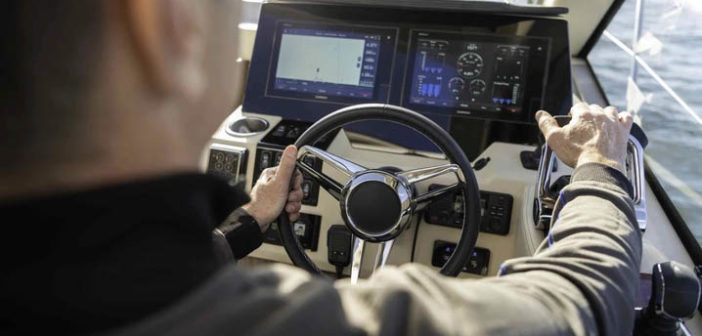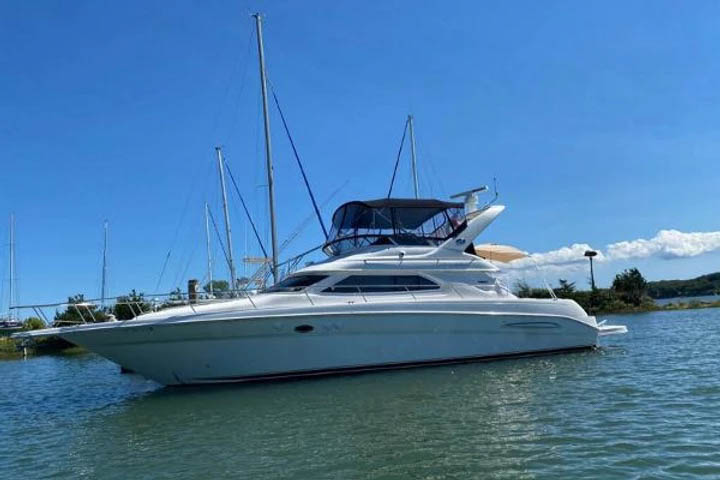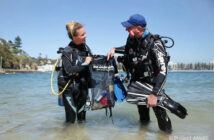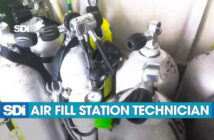Enjoy Captain Bill Jenkins article.
Readers have asked me to write about driving a boat when you are alone. Truth is, alone is much the same as with others. But over time, I have identified a few differences that I call “quirks.” A couple of years ago, I took a full day solo trip where some good examples of these ‘quirks’ showed up. Here is the story of that trip.
My Sea Ray 450 Express Bridge was in Friday Harbor, Washington and I needed it in Vancouver, BC. This would be a fun trip if I could find someone to join me. But it was a Thursday and I needed the boat in Vancouver’s False Creek on Saturday, so I decided to do the run myself, figuring seven hours of travel time would allow me to make it in a single day. My good friend George agreed to fly me down to the boat early Friday morning.
We were wheels up from Pitt Meadows, BC, airport at 8:15 AM in George’s Comanche 260, and in 25 minutes we were sitting on the US Customs ramp at the Bellingham Airport. From there, it was a short 20 minute flight to Friday Harbor on San Juan Island. Interestingly, this airport requires some special attention because the single strip runway is built on the side of a hill, so depending on the direction you try to land, the runway is either escaping beneath you, or coming up to meet you. We found the asphalt with no problems and I gathered my duffel bag with spare clothes and my rubber sea bag with an inflatable vest and accessories such as a knife, compass, warm jacket, and portable radio. For my float plan, I simply promised George I would check in with him that evening. After a short walk to the marina I prepared the Sea Ray for departure.
The amount of time that I spend preparing for solo trips depends on the length of the trip. Very short trips to local destinations require minimal planning, but this would be an international trip over some big water. Describing a long check list of things to do and take with you on such a trip would be a waste of your time because such preparations vary with the different boat types and where you are boating. I did check that the electronics were operational, including the GPS and basic radar. My helm did not have an AIS.
One important tip before every solo trip, is to sit down with a chart and mentally take yourself through every step of the journey. In this case, maximum fluids seemed prudent. As I topped everything up, I noticed that the coolant was low on the starboard engine, so I picked up an extra quart. Weather information and forecasts for solo trips are very similar to what you would review before any trip — tides, wind, currents, precipitation, and visibility.
It was after 11:15 AM before I pulled out of Friday Harbor and headed north. While still at idle, I pulled in fenders and lines and found a cold bottle of water to keep at the helm. As I made my way through the San Juan Islands, I noticed the first one of those solo ‘quirks.’ Time was moving slowly, and my progress seemed slower than it actually was. I kept checking my watch every few minutes. After crossing into Canadian waters, things picked up a bit and I was soon pulling into Bedwell Harbour, on Pender Island, to report to Canada Customs. Reporting directly and swiftly to customs is very important. They tend to do mean things, like seize your boat, if you fail to do this.
On checking coolant levels, I found the starboard coolant level had again dropped, so I dumped in the spare quart that I brought. While the stop took longer than I had planned, I was still on schedule and was soon cruising north, up the inside of the Gulf Islands. At this stage I began to experience ‘quirk’ number two — you think you hear things. What is that ticking sound? Was that a thump? Did I run over something? When you have someone to talk to, you don’t hear such things. I solved this symptom by popping in my ear buds and turning on some quiet music.
My plan was to exit the Gulf Islands through Active Pass and head north east, across the Strait of Georgia, to Vancouver, arriving just before dark. I stopped before entering the pass for a final check. No joy. The coolant was lower than ever and the weather called for winds out of the west at 21 mph. Such winds meant that I would encounter rougher seas as I got closer to Vancouver. Here is where the next quirk of solo trips occurred — I call it the “I really need to get to my destination and I can do this” phenomena. At least I didn’t encounter any of the province’s huge 400 car ferries as I maneuvered through Active Pass.
The water east of the islands began as simple swells. Approaching mid-point, the waves on the Strait of Georgia were on my left rear quarter. This scenario necessitated that I set a speed just greater than that of the waves, plus continuous steering input to avoid the possibility of broaching. As wave heights reached five feet, an overheat alarm sounded. Yep, the starboard engine. I figured I should probably save that engine for easier close docking upon arrival and since one engine could maintain the speed I wanted, I shut down the starboard engine. At first, the temperature rose further, but then it began to cool nicely. As I closed in on English Bay, it became increasingly difficult to find sufficient steerage to keep the boat pointed in the right direction. The waves and port engine were pushing my bow to starboard. Rather than end up on the rocks of Point Roberts, to the south, I tried flicking on my bow thruster periodically to hold my heading. It worked. Encountering something you don’t expect is another ‘quirk’ of solo travel. If you can stay cool and solve the problem, that is a bonus.
Another quirk of driving alone is that no matter how carefully you secure items in the cabins, something will always work its way loose and smash to the floor — and it did. But I would look into this latter. With darkness setting in the Point Atkinson light was a welcome sight and my GPS identified each of the English Bay entry buoys. Maybe this is not really a quirk, but I can assure you that solo boating always takes longer than you figure. It was already 9:25 PM.
Entering False Creek, I made ready my fenders and lines and restarted the starboard engine. I tucked into my slip, pitched both lines across the dock and jumped off to make them secure. The reality of this solo trip was that I was never in any life-threatening situations, or even close. But on a solo trip you can expect the unexpected and they can get progressively worse. So plan your trip in detail and execute your plan, one step at a time. Quirks will happen, but they seem to always go away.
After such a trip, the story should end with me in the local pub, drinking a beer, and chatting up my sea buddies. Truth is, I went directly home and jumped into bed.










